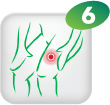At YuillBeFixed, The Family Health Clinic, we provide Tailored Treatments and Massages
for all the family. The following description is the service a client can expect to receive when
they visit our clinic for a deep muscle treatment regarding their Thighs.
Treatment NO.6 Deep Muscle Treatment Thighs

At YuillBeFixed the massage therapist will use Swedish massage and specialised warming techniques to circulate and pump blood flow through the lliotibial band for about 20 minutes, it is a superficial sheet of facia with vertical fibres that run along the lateral thigh. It emerges from the gluteal fascia, is wide and dense over the vastus lateralis muscle and funnels into a strong cable along the side of the knee before inserting at the tibial tubercle. The fibres of tensor fasciae latae and some fibres of gluteus maximus attach to the proximal aspect of the lliotibial band (tract). The lliotibial band has a thick, matted texture (similar to packing tape) that makes it strong stabilizing component of the hip and knee.
The YuillBeFixed massage therapist will then foam roll the outside thigh with specialised techniques to investigate the clients outside leg for holding patterns and to discover where they have ischemia (meaning knots or constricted blood) or Trigger points that refer pain to other parts of the leg. The band Or tendon does not have a lot of blood flow and this can cause the muscles down the side of the leg to tighten , so you’re talking about a tendon that stretches from your hip to your knee which also means it crosses two joints which help control the angle of the lower leg while running or walking. The YuillBeFixed therapist will create new blood flow to the areas of the muscle in the leg which had biomechanical problems bringing correct alignment back to the client’s leg improving performance and functional ability.
The YuillBeFixed therapist when discovering a Trigger points (referral pain to another area of the leg) has been trained to de-programme this pain from the nervous system and like roads that lead to different places so nerves in the body can bring pain patterns done to overly tight and worked muscles and tendons. The therapist will ask the client 3 questions when working with the pressure on the areas of the leg that are tight and constricted.
1”is the point tender and on a pain scale of 1-10, what number are you, 10 being the pain is too much.
The appropriate number is quickly found and work continues, which is on a pain scale around 6-7 which is a pleasurable discomfort but can be controlled with breathing by the client.
2 “dose the pain refer to another part of the body”?
In other words is the area being compressed a trigger point (referring pain) or is it ischemia (meaning a knot or constricted blood) which can be trapped in the muscle of the leg.
3 “if it is a Trigger point the YuillBeFixed massage therapist are trained to find them and compress them, they will ask the client about the pressure on the Trigger point (that’s referring pain to another part of the leg).If it is within the pleasure /pain limits which is around 6-7 out of 10 for pain, our therapists will ask the client when the referred sensation changes, the therapist will want to know the affect their pressure is having on the trigger point. This will enable the massage therapist to de-program these regular pain patterns that come down the body from the brain and the client’s nervous system, this blocks the neural gate and pathways of pain by introducing pleasure and a new influxes of fresh blood back into the clients muscle, which was not happening in the first place, these are the reasons that Neuromuscular therapy and deep tissue therapy work with returning blood flow back to areas of tightness in the clients leg.
This can be intense due to years of pain and tightness held within the client’s body, however at YuillBeFixed the massage therapist will always leave time to disperse any tension within the muscles of the leg and give pleasure back to the nervous system.
Tags: lliotibial Band Impingement Syndrome, lliotibial band pain, lliotibial band syndrome, ITB pain, thigh pain, knee pain, quad pain, leg pain, outside leg pain, bad leg, leg hurts, sore leg, hip or knee pain, Running injury. |
|